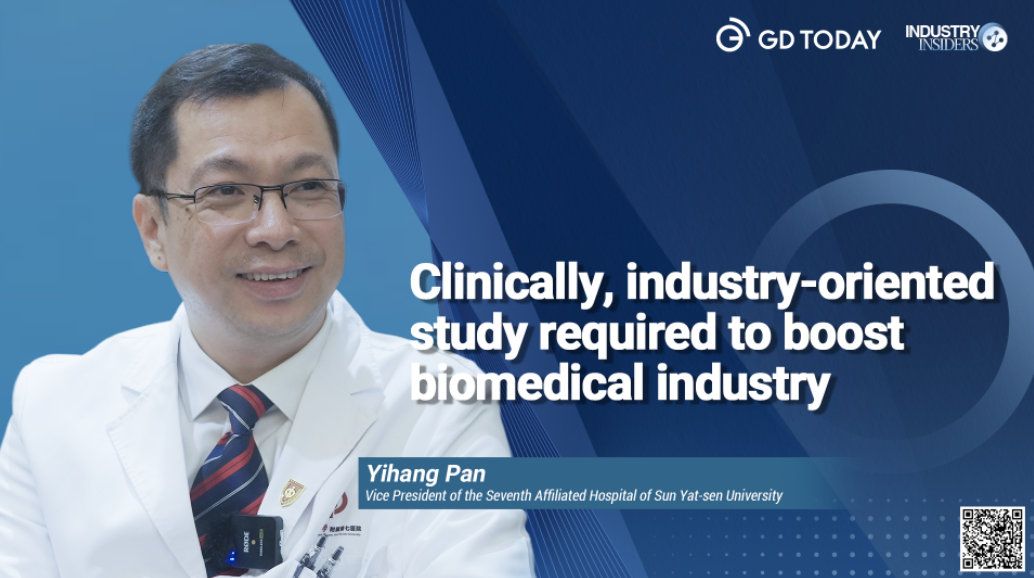“Universities, hospitals, biomedical companies, and local governments should join hands and make plans to promote the biomedical industry. It also includes how to bring in talents and technologies, so as to truly serve the health of the people,” said Yihang Pan, Vice President of the Seventh Affiliated Hospital of Sun Yat-sen University (SAH-SYSU), and Vice Dean of SYSU School of Medicine.
Guangdong aims at improving the existing eight trillion-RMB industrial clusters, while also nurturing new trillion-RMB clusters in such areas as ultra-high-definition video displays, biomedicine and healthcare, and new energy, according to the 2023 Guangdong government work report.
“To achieve this goal, we need to push forward clinically-oriented and industry-oriented research,” Pan comments.

Returning to China and building a hospital for alma mater
Being touched by the enthusiasm and potential of SYSU and Shenzhen, Pan returned from the United States in March 2017 to start up the SAH-SYSU. “In the early days after my returning to China, my friends came to see me and considered the conditions of the construction site were so difficult. But they were surprised that the team were still so excited every day, and I looked confident of success.”
He recalled, “Being able to return to my alma mater to participate in the construction of a hospital is a precious opportunity for me. And it’s a good platform for clinically-oriented research, translational development, and scientific breakthroughs.”
Not far from the SAH-SYSU, the SYSU Shenzhen Campus has recently completed its first construction phase. The campus features new engineering, medical science, and agricultural science, focusing on China’s strategic emerging technologies, Shenzhen’s innovative development and future industrial planning.
“In the second phase of our hospital, we will build a 10,000-square-meter biological specimen bank, and provide a total of 4,000 beds for the public,” said Pan.
He added, “We also visited internationally renowned research institutions, including UCL, the Francis Crick Institute, and many scientific research institutions in the United States. We have been communicating with several Nobel Laureates, and launched two Nobel Laureate laboratories.”
In order to illustrate how research has advanced, Pan used a study on pancreatic cancer spread reversal led by SAH-SYSU Honorary Professor Axel Behrens as an example. The research found that the GREM1 protein is very important for pancreatic cancer, which can turn pancreatic cancer into cysts.
Why would they cooperate with SAH-SYSU? Pan believes it's because Shenzhen is dedicated to fostering the growth of the biomedical sector.
A biomedical industry chain being formed in Shenzhen's Guangming
In recent years, Shenzhen has positioned the biomedical industry as a key industry for development. “Along with the integration of medical science and engineering, we started to build the SAH-SYSU in 2016. It continues to expand, attracting more biomedical companies to settle here,” Pan said.
Pan noted that their researchers are required to spend 70 percent of their time on clinically-related subjects, and they have to cooperate with clinical departments.
The Shenzhen Bay Laboratory was soon established, and the Shenzhen Medical Academy of Research and Translation (SMART), led by Biologist Yan Ning, also chose Guangming.
In 2020, the Guangming Science City has been approved as the fourth comprehensive science center in China. Previously, China has approved the establishment of three comprehensive national science centers in Beijing, Shanghai, and Hefei, Anhui Province.
Statistics show that in 2022, Guangdong's biomedicine and healthcare industry cluster achieved an operating income of 411.283 billion RMB, a year-on-year increase of 14.71 percent. It has already built 10 comprehensive biomedical industrial parks and cultivated two enterprises with more than 50 billion RMB in sales revenue.
Link to the report: https://www.newsgd.com/node_99363c4f3b/9e8db15df9.shtml



